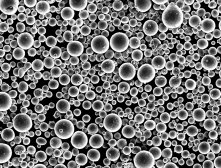There are several methods to make metal 3D printing powder:
1. Mechanical Pulverization
Solid metal mechanical crushing method is an independent powder making method and can be used as a complementary process to some powder making methods. Relying on the role of crushing, smashing and grinding, the bulk of the metal, alloy or compound crushed into powder. The final degree of crushing can be divided into two categories: coarse crushing and fine crushing.
To further reduce or increase the size of the powder, alloying of the powder can select mechanical grinding
Applicable materials: Fe, Al, pure Ti powder and Fe-based alloys
2. Atomization Method
Atomization is a process in which liquid metals and alloys are broken directly into fine droplets that solidify quickly to form a powder. A high-velocity air or water stream is both the driving force and the coolant for the broken metal liquid stream. Any material that can form a liquid can essentially be atomized.
For low melting point metal powder, the granulation process is to let the molten metal through a small hole or screen automatically into the air or water, condensing to get metal powder, this method of making powder particle size coarse;.
Another method of preparing fine powder: water atomization or gas atomization method; centrifugal atomization method; and supersonic pulse inert gas atomization method. Take titanium alloy powder as an example, the titanium alloy powder is melted and atomized into fine droplets by high purity argon gas airflow, which falls under the action of gravity through the inert airflow, and the process of solidifying the fine particles into powder under its cooling.
At present, there are more applications of vacuum atomization method and inert gas atomization method (especially suitable for the preparation of active metal powder).
Applicable materials: Fe, Cu, refractory metals, stainless steel, Ti alloy, etc.
3. Reduction Method
The reduction is a method to produce metal powder by reducing metal oxides and salts with a reducing agent, where the reducing agent can be in solid, gaseous, or liquid form. Including carbon reduction method, gas reduction method, hydrogen reduction method, metal thermal reduction, the
Suitable materials: Fe, W, Ta, Zr as representatives of rare metals and refractory metal powders
4. Chemical Vapor Deposition (CVD)
Chemical vapor deposition using metal vapor condensation with a vapor phase reductant. These materials are characterized by a low melting point and a high volatility.
5. Electrolytic Method
A method of depositing powder from the cathode of an electrolytic cell under certain conditions. The electrolysis method is second only to the reduction method in terms of frequency of use. Although the manufacturing cost is high, the preparation purity is also high, and it has a similar purification effect on metal powder.
Principle: Chemical electrolysis
Applicable materials: Fe, Cu, Ni, Ti, and other metal powders, and intermetallic compounds.
6. Rotating Electrode Com-minuting Process
Currently the largest production scale and the most representative high-temperature alloy powder preparation method: plasma rotating electrode powder making method (i.e. PREP method), which prepares powder with good shape (round spherical), less porous powder and low oxygen content. This method is more costly and generally suitable for aerospace and biomedical fields.
Principle: The plasma gun is used to generate plasma flow in the sealed atomization chamber to melt the end of the high-speed rotating alloy bar material motor, and the liquid metal is atomized into very small droplets under the action of centrifugal force at the initial stage of the fly shot and cooled in the inert gas.
Applicable materials: Ni-based and other refractory metals, Ti and other active metals.
7. Spheroidizing Method
Spheroidization method mainly has: RF plasma spheroidization, laser plasma spheroidization and other heat sources of spheroidization
Principle: Take plasma spheroidization as an example: irregularly shaped titanium powder particles mixed with inert gas are added to the plasma torch, which is rapidly heated and melted by the plasma torch, and the molten particles form droplets with high sphericity under the action of surface tension, and spherical powder is obtained by rapid cooling in a very short time.
Applicable materials: mainly used for the secondary processing of irregular metal powder.





